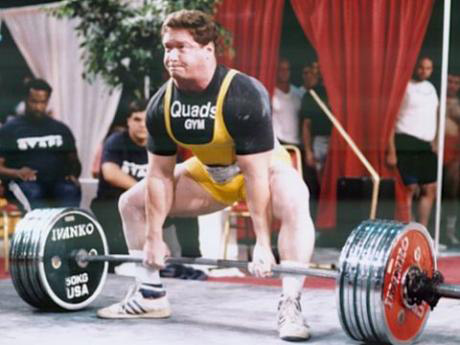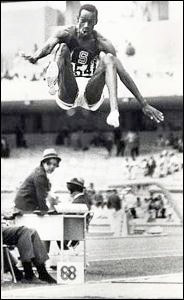
Understanding the greatness of Ed "King" Coan
In our biased opinion, Coan was the greatest strength athlete of the 20th century
Featured Strength Equipment: barbell
Bob Beamon's incredible leap was called "The greatest single human athletic feat in history." The whole thing took six seconds: his runway sprint was 19 strides before taking off and attaining a height of over 6-feet (shown) mid-flight. He could have cleared a 1968 VW Micro-Bus. Bob raised the record from 27 feet 4.25 inches to 29 feet 2.5 inches, representing a 6% increase. To equal Coan's 15% dominance Beamon would have had to leap 32 feet.

Ed "King" Coan is, in my not-so-humble opinion, the greatest strength athlete of the 20th Century. Who could rival him? In powerlifting only 16-time world champion Lamar Gant (688 deadlift at 132 pounds) could be mentioned in the same breath as Coan. In Olympic weightlifting the 20th century contenders would be John Davis, Paul Anderson, Tommy Kono, David Rigert and Vasily Alekseev. I would respectfully point out that none of these men, despite their awe-inspiring accomplishments, were ever as far ahead of their competitors as Ed Coan was ahead of his at one remarkable point in time.
At his mind-blowing peak Ed Coan was mathematically a full 15% better than the rest of the world. Ponder that fact: a 15% gap between one man and the rest of the world is unprecedented in all of sport. Most experts would point to Bob Beamon's 29-foot long jump at the 1968 Mexico Olympics as the greatest single athletic advancement over an existing record in history. Beamon's 29-foot leap exceeded Igor Ter-Ovanesyan world record of 27 feet 4.25 inches by a margin of 21¾ inches. By way of comparison, Beamon's leap represented a 6% increase over the world record. Beamon's broad jump world record stood for 23 years until it was broken in 1991. To equal Coan's dominance Beamon would have had to soar 32 feet.
To equal Coan's 15% advantage a sprinter would need to slash Usian Bolt's 9.58 WR by 1.45 seconds and run a 8.15 second 100 meter dash. The current world record in the high jump, 8 feet ¼ inch would need to be raised to 9 feet 2 inches. The all-time world record of 75 feet 10 inches in the shot put would have to be increased to 87 feet to equate to Coan's 15% superiority.
Weighing 219 pounds, Ed squatted 959 pounds below parallel, bench-pressed 550 without a bench shirt and deadlifted a historic 901 pounds. He remains, by far, the lightest man to deadlift 900. And note that this deadlift was not done in a deadlift-only competition: Ed pulled 900 after squatting 920, 940 and 959 and after having deadlifted 830 - all before tackling 900. Talk about back and leg pre-fatigue!
What could he have done on that day in a deadlift-only competition? 930 to 940 pounds seems reasonable. In the run up to this historic competition Ed had actually doubled a 900 pound deadlift in training. The 900 barbell pull was done on his second attempt deadlift: Coan actually tried 920 on his 3rd attempt but after all the excitement and hoopla that exploded when he pulled the 900, it let some of the air out of his tires.
On that day Ed Coan generated a three-lift (squat/bench press/deadlift) aggregate total of 2,400 + pounds. This total, made in the 220-pound class, exceeded the world total record in the 242 and 275 pound classes. At the time Coan was the 5th man to join the 2,400-pound total club. He was, by far, the lightest man to attain membership. The 2400 club was exclusive, the Mount Everest of power achievements.
The guys that Ed Coan was ahead of in the 220-pound class were no bunch of sissies or under-achievers, they included future hall-of-fame powerlifters, iron icons in their own right, men like Joe "The Lad" Ladiner, Fred "Dr. Squat" Hatfield (880 squat weighing 220,) 9-time world champion Larry Pacifico with a 580-pound raw bench press and Jim Cash, a man with an 837-pound deadlift. These amazing men finally broke the seemingly insurmountable 2,100-pound three lift total barrier with great fanfare. Then came Coan.
On hearing the news that Coan would be moving into his weight class, one nationally ranked 220-pound competitor solemnly responded, "Well that's bad f#@king news for the rest of us." He was then seen heading to a bar. Indeed this was bad news for his competitors. As a 198-pound lifter, Ed had crushed every record in sight. The 2,000-pound total was the international benchmark for the 198-pound class and when Coan totalled 2,200 at 198, he became 10% better than the rest in the world. As a 198er Coan squatted 859, bench-pressed 500 raw, and then deadlifted 859 on a 2nd attempt, just missing 870 on a 3rd. We began to think he was a space alien. For those in the know, Coan was a genuine strength superstar, the likes of which we had never seen before. Incredibly he kept improving past any and all realistic expectations.
Out of the blue, the greatest lifter in the history of the sport picked me to be his competition coach. I didn't even know I was being considered. The day before the national championships in a chance encounter in the street, he informed me that he would like me to be his competition coach the next day - oh, and there is no real need to get together beforehand and talk and bond and become BFFs - just show up at the meet site two hours before the lifting begins. Thus began my official and ongoing relationship with Ed Coan.
Like a strength Forest Gump, I somehow ended up as Ed Coan's competition coach. I coached him on the two times that he had his two greatest lifting performances. For a power aficionado like myself, this was literally a dream come true. Could there be a better ringside seat? I was Angelo Dundee for Ali and Sugar Ray; I was Cus D'Amato for Mike Tyson. In the white-hot heat of competition, when national and world titles were on the line, I became the best in the world's pit crew chief.
For five years Ed and I talked extensively, 2-3 times weekly for at least an hour. He and I were both fascinated by the strength training, the nuts-and-bolts work done in the gym: we pondered together our mutual Rubik's Cube, "the eternal question," If the goal is to become as strong as possible in the three lifts, how best do we use our available training time? How best do we optimize lift performance? Coan and I talked strength philosophy at length. He was a thinker and a sophisticate: too many passed him off as a genetic freak and that was not the case.
I came out of the Hugh Cassidy school of strength whereas Ed came out of the Ernie Frantz Midwestern school of strength. Hugh and Ernie had come to many of the same strength conclusions, independent of one another and now, as Ed and I compared notes, the mid-Atlantic and mid-western similarities far exceeded the differences. Ed had developed a strong relationship with uber-athlete, rodeo star turned football star turned powerlifting superstar Doug Furnas. World champion Dennis Wright lived in Oklahoma rodeo country and mentored Doug. Dennis' southwestern conclusions, as told by Doug to Ed, echoed Ernie and Hugh's conclusions. An unarticulated strength consensus was emerging.
Coan's weight training template was an amalgamation: our mentors had laid the foundation and this was combined with empirical experience. We were the inheritors: the mentors, Dennis, Ernie and Hugh, had pointed the way. Ed, Doug and I shared ideas: the conversations I had with these men - and I would add to that list bench press God Ken Fantano - were directly responsible for "hatching" future hall-of-fame lifter Kirk Karwoski.
I would talk to Ed weekly about "that kid with the big legs" as Ed called Kirk before he finally remembered his name. When I started applying Coan ideas to Kirk's training Kirk exploded. He had a rock-solid foundation, having worked with 775-deadlifter Joe Povinale and Marshall "Doc" Peck. When we got Kirk on the "modified Ed" routine, Kirk body and his lifts exploded. Kirk had the mindset, the situation (a single bachelor with a good job) the drive and the genetics. Kirk ate up whatever Ed and I devised. Within five years Kirk was an indomitable world champion. His barbell squat records stand to this day.
As an outgrowth of our extended conversations on and about training, and as a result of being the pit crew chief for Ed Coan in big league competitions, I wrote a book on Ed and his exploits called, Coan, the man, the myth, the method. The title pretty much says it all. I chronicled Ed. I profiled him as a person, I portrayed a feel for the environment that spawned him, I documented his competitive career on a competition-by-competition basis and we went into great depth and detail the specifics of his training. Ed was a thinking man's lifter, a sophisticate, but a brutal and harsh sophisticate. Properly implemented, Coan's protocols always get results. Check them out.
About the Author
As an athlete Marty Gallagher is a national and world champion in Olympic lifting and powerlifting. He was a world champion team coach in 1991 and coached Black's Gym to five national team titles. He's also coached some of the strongest men on the planet including Kirk Karwoski when he completed his world record 1,003 lb. squat. Today he teaches the US Secret Service and Tier 1 Spec Ops on how to maximize their strength in minimal time. As a writer since 1978 he’s written for Powerlifting USA, Milo, Flex Magazine, Muscle & Fitness, Prime Fitness, Washington Post, Dragon Door and now IRON COMPANY. He’s also the author of numerous books including Purposeful Primitive, Strong Medicine, Ed Coan’s book “Coan, The Man, the Myth, the Method" and numerous others. Read the Marty Gallagher biography here.

